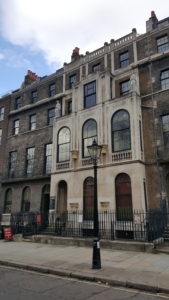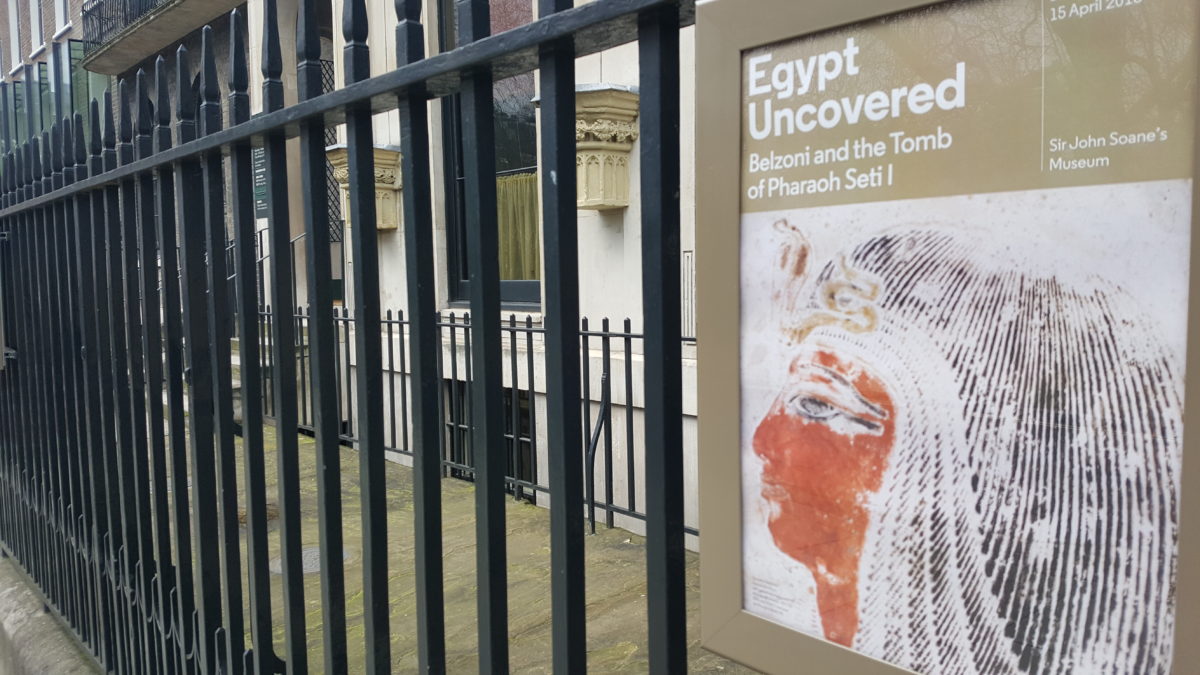Egypt Uncovered: Belzoni and the tomb of Pharoah Seti I – Sir John Soane’s Museum, London
Despite having been in London for close to eight years and having a personal and professional interest in museums, this was my first trip to Sir John Soane’s Museum. I can’t believe it took me that long! It is a slightly crazy place in the tradition of English eccentrics, a fascinating window into Enlightenment collecting and art history, and a quirky museum set up. As this was my first visit most of the below covers the museum itself, although there’s also a bit on the current temporary exhibition on their star exhibit, the sarcophagus of Seti I.
A bit of history to begin with. Sir John Soane, the son of a bricklayer, established himself in late 18th Century society, first as an architect and then by marrying well. Over a period of 30 years or so he bought three adjacent houses across from Lincoln’s Inn Fields, knocked them through into one house, and set up a museum, arranging through an Act of Parliament for the house and museum to be preserved after his death and left to the nation. Just moving through the museum is a strange experience. It is full of nooks and crannies, narrow corridors, grates passing from one floor to another, mirrors giving an impression of hidden spaces, and the end result I found to be slightly discombobulating, particularly when you’re trying not to knock anything over. And there is plenty to be knocked over: in true Georgian and/or Enlightenment fashion it is jam packed with artefacts and artworks. Perhaps more Georgian than Enlightenment on balance: the aim is not a categorisation or comprehensive survey of anything, and natural history is almost entirely absent, so it’s more a mish-mash of classical art history, a nice library, and some excellent paintings, squashed into the three houses with a kind of Wunderkammer aesthetic.
It would take many trips to see everything, but a few things certainly made an impression on me, like the ‘crypt’, an atmospherically lit corner set out like a colombarium and housing Roman funerary monuments and the like, or the fairly frequent death masks dotted around the place. Another aspect I found interesting was the equal pegging of originals and plaster casts. Like the Cast Courts at the V&A, it just goes to show how much fashions and art historical perspectives change over time, in this case the mostly 20th Century view that it’s only the original that’s worth something, and a copy is a copy. Soane had no such qualms, so there are a large number of casts in his collection, both of famous and lesser known works.
The paintings largely play second fiddle to the museum proper: there are some nice works by Sir Thomas Lawrence, Canaletto, Turner and others, but, compared to the intricate, architecturally complex spaces housing the collection of artefacts, the rooms with paintings as their focus are much more quickly passed through by the average visitor. The main point of interest for me in the painting collection was the ingenious way that Soane established to maximise viewing space on the ground floor, with ‘moveable planes’ in the Picture room opening out like cupboard doors to reveal paintings hung on the opposite side. It explains a mystery the visitor encounters downstairs, where paintings are visible high above, but with no apparent means of getting close enough to see them. They are some of the other faces of the planes, not currently swung around for convenient viewing.
So, from a museological perspective what did I think? Well, it’s really a fascinating window into the role of passionate individuals in assembling early collections, the spilling over of the private into the public sphere, the exploration of Egypt and its effect on history and art history, the neoclassical-loving Georgians, and other layered narratives. It’s presumably difficult, given the restrictions imposed by Soane that the house/museum remain as they were at the time of his death, to do anything revolutionary in terms of interpreting the collections, so it’s mainly a nice walk through the rooms and then out again into the streets. But, given that they haven’t used their website for this either, their offering of events appeals mainly to what I would imagine is their core demographic, and the main creative tie-ins seem to be in the shop, perhaps this just isn’t a priority. And fair enough: I doubt that attracting a wider pool of visitors is part of their mission when the self-selecting audience probably keeps them at capacity much of the time. And so my overall impression is of a moment preserved in aspic: both in terms of Soane’s wishes, and in the sense that the visitors today struck me as an updated but similar bunch to those who might have visited almost 200 years ago.
A final word on the temporary exhibition, Egypt Uncovered: Belzoni and the tomb of Pharoah Seti I. Opened in 2017 to coincide with the 200th anniversary of the rediscovery of the museum’s star attraction, a wonderful calcite Egyptian sarcophagus, this exhibition explores the story of discovery and discoverer, one very much intertwined with the other. Giovanni Battista Belzoni was a famous explorer very much in the 19th Century mould. Starting out as a strong man in circuses, he went off to Egypt where he impressed Sir Henry Salt, then Consul-General of Egypt and active in excavating artefacts both for the British Museum and for his own purposes. It seems to have been a bit of a battle as to who profited financially and reputationally from discoveries like the tomb of Seti I, with Salt selling the sarcophagus to Soane, while Belzoni published tales of his exploits. The exhibition teases out this sense of big personalities, particularly Belzoni’s, but also brings together artefacts and images from the tomb itself, some from the Sir John Soane’s Museum’s own collection but rarely displayed due to fragility, as well as new resources like a high definition 3D rendering of the sarcophagus itself. Spread over two rooms, it’s not an exhaustive exhibition, but gives an interesting look at the context in which Soane was collecting as well as his delight in acquiring and exhibiting the sarcophagus.
So if this all sounds like your type of place then by all means head to the Sir John Soane’s Museum, it’s wonderful, and I mean that sincerely. If you want to be challenged by your cultural outings then you probably won’t find that here, but if you like history, art history, architecture, quirky British people, or any combination of these interests, then you should plan a visit immediately.
Egypt Uncovered until 15 April, free entry


One thought on “Egypt Uncovered: Belzoni and the tomb of Pharoah Seti I – Sir John Soane’s Museum, London”